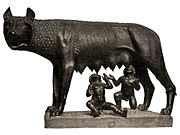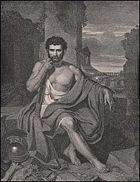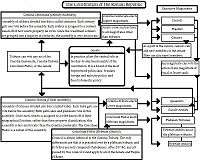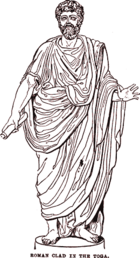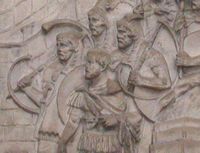Ancient Rome
2008/9 Schools Wikipedia Selection. Related subjects: Ancient History, Classical History and Mythology; General history
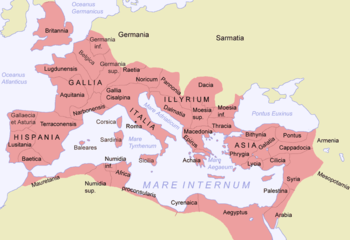
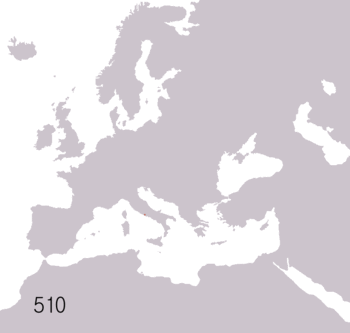
Ancient Rome was a civilization that grew from a small agricultural community founded on the Italian Peninsula in the 9th century BC to a large empire straddling the Mediterranean Sea. In its twelve centuries of existence, Roman civilization shifted from a monarchy, to a republic based on a combination of oligarchy and democracy, to an increasingly autocratic empire. It came to dominate Western Europe and the area surrounding the Mediterranean Sea through conquest and assimilation.
The Roman empire went into decline in the 5th century AD. Plagued by internal instability and attacked by various migrating peoples, the western part of the empire, including Hispania, Gaul, and Italy, broke up into independent kingdoms in the 5th century. The eastern part of the empire, governed from Constantinople, survived this crisis, and would live on for another millennium, until its last remains were finally annexed by the emerging Ottoman Empire. This eastern, medieval stage of the Empire is usually referred to as the Byzantine Empire by historians.
Roman civilization is often grouped into " classical antiquity" with ancient Greece, a civilization that inspired much of the culture of ancient Rome. Ancient Rome contributed greatly to the development of law, war, art, literature, architecture, technology and language in the Western world, and its history continues to have a major influence on the world today.
History
Monarchy
According to legend, Rome was founded on April 21, 753 BC by twin descendants of the Trojan prince Aeneas, Romulus and Remus. The Latin King Numitor of Alba Longa was ejected from his throne by his cruel brother Amulius and Numitor's daughter, Rhea Silvia, gave birth to Romulus and Remus. Rhea Silvia was a Vestal Virgin who was raped by Mars, making the twins half-divine. The new king feared that Romulus and Remus would take back the throne, so they were to be drowned. A she-wolf (or a shepherd's wife in some accounts) saved and raised them, and when they were old enough, they returned the throne of Alba Longa to Numitor. The twins then founded their own city, but Romulus killed Remus in a quarrel over which one of them was to reign as the King of Rome, though some sources state the quarrel was about who was going to give their name to the city. Romulus became the source of the city's name. As the city was bereft of women, legend says that the Latins invited the Sabines to a festival and stole their unmarried maidens, leading to the integration of the Latins and the Sabines.
The city of Rome grew from settlements around a ford on the river Tiber, a crossroads of traffic and trade. According to archaeological evidence, the village of Rome was probably founded sometime in the 8th century BC, though it may go back as far as the 10th century BC, by members of the Latin tribe of Italy, on the top of the Palatine Hill. The Etruscans, who had previously settled to the north in Etruria, seem to have established political control in the region by the late 7th century BC, forming the aristocratic and monarchial elite. The Etruscans apparently lost power in the area by the late 6th century BC, and at this point, the original Latin and Sabine tribes reinvented their government by creating a republic, with much greater restraints on the ability of rulers to exercise power.
Republic
The Roman Republic was established around 509 BC, according to later writers such as Livy, when the last of the seven kings of Rome, Tarquin the Proud, was deposed, and a system based on annually elected magistrates and various representative assemblies was established. A constitution set a series of checks and balances, and a separation of powers. The most important magistrates were the two consuls, who together exercised executive authority in the form of imperium, or military command. The consuls had to work with the senate, which was initially an advisory council of the ranking nobility, or patricians, but grew in size and power over time. Other magistracies in the Republic include praetors, aediles, and quaestors. The magistracies were originally restricted to patricians, but were later opened to common people, or plebeians. Republican voting assemblies included the comitia centuriata (centuriate assembly), which voted on matters of war and peace and elected men to the most important offices, and the comitia tributa (tribal assembly), which elected less important offices.
The early 5th Century BCE saw an influx of Gauls (Gallic Celts) push south of Cisalpine Gaul into Etruscan territory, which they took by force of arms. The Gauls were led by Brennus of the Senones tribe, and the Romans sent an envoy of three delegates to meet with him and determine his intentions and, covertly, the strength of his army. The meeting did not go well, and ended in violence. Brennus, taken aback by what he referred to as a violation of the Laws of War, demanded the three Romans be handed over to him for punishment. The Romans refused, leading the Gauls to march on Rome in July, 387 BC. In response, the Romans, under A.Quintus Sulpicius, attempted to form a defense against the approaching Gauls. The result was a crushing defeat of the Romans near the River Allia, and the subsequent sack of Rome. The Romans retreated to the citadel on the Capitoline Hill, and remained in relative safety as they watched the looting and burning of the city. After a period of seven months of Gallic occupation of the city, the Romans approached Brennus for terms of peace. Brennus settled on the sum of one-thousand pounds of gold, and the Gauls subsequently departed Rome.
The Romans gradually subdued the other peoples on the Italian peninsula, including the Etruscans. The last threat to Roman hegemony in Italy came when Tarentum, a major Greek colony, enlisted the aid of Pyrrhus of Epirus in 281 BC, but this effort failed as well. The Romans secured their conquests by founding Roman colonies in strategic areas, establishing stable control over the region. In the second half of the 3rd century BC, Rome clashed with Carthage in the first of three Punic Wars. These wars resulted in Rome's first overseas conquests, of Sicily and Hispania, and the rise of Rome as a significant imperial power. After defeating the Macedonian and Seleucid Empires in the 2nd century BC, the Romans became the dominant people of the Mediterranean Sea.
Foreign dominance led to internal strife. Senators became rich at the provinces' expense, but soldiers, who were mostly small-scale farmers, were away from home longer and could not maintain their land, and the increased reliance on foreign slaves and the growth of latifundia reduced the availability of paid work. Income from war booty, mercantilism in the new provinces, and tax farming created new economic opportunities for the wealthy, forming a new class of merchants, the equestrians. The lex Claudia forbade members of the Senate from engaging in commerce, so while the equestrians could theoretically join the Senate, they were severely restricted in terms of political power. The Senate squabbled perpetually, repeatedly blocking important land reforms and refusing to give the equestrian class a larger say in the government. Violent gangs of the urban unemployed, controlled by rival Senators, intimidated the electorate through violence. The situation came to a head in the late 2nd century BC under the Gracchi brothers, a pair of tribunes who attempted to pass land reform legislation that would redistribute the major patrician landholdings among the plebeians. Both brothers were killed, but the Senate passed some of their reforms in an attempt to placate the growing unrest of the plebeian and equestrian classes. The denial of Roman citizenship to allied Italian cities led to the Social War of 91–88 BC. The military reforms of Gaius Marius resulted in soldiers often having more loyalty to their commander than to the city, and a powerful general could hold the city and Senate ransom. This led to civil war between Marius and his protegé Sulla, and culminated in Sulla's dictatorship of 81–79 BC.
In the mid-1st century BC, three men, Julius Caesar, Pompey, and Crassus, formed a secret pact—the First Triumvirate—to control the Republic. After Caesar's conquest of Gaul, a stand-off between Caesar and the Senate led to civil war, with Pompey leading the Senate's forces. Caesar emerged victorious, and was made dictator for life. In 44 BC, Caesar was assassinated by senators who opposed Caesar's assumption of absolute power and wanted to restore constitutional government, but in the aftermath a Second Triumvirate, consisting of Caesar's designated heir, Octavian, and his former supporters, Mark Antony and Lepidus, took power. However, this alliance soon descended into a struggle for dominance. Lepidus was exiled, and when Octavian defeated Antony and Cleopatra of Egypt at the Battle of Actium in 31 BC, he became the undisputed ruler of Rome.
Empire
With his enemies defeated, Octavian took the name Augustus and assumed almost absolute power, retaining only a pretense of the Republican form of government. His designated successor, Tiberius, took power without serious opposition, establishing the Julio-Claudian dynasty, which lasted until the death of Nero in 68. The territorial expansion of what was now the Roman Empire continued, and the state remained secure, despite a series of emperors widely viewed as depraved and corrupt (for example, Caligula is argued by some to have been insane and Nero had a reputation for cruelty and being more interested in his private concerns than the affairs of the state). Their rule was followed by the Flavian dynasty. During the reign of the " Five Good Emperors" (96–180), the Empire reached its territorial, economic, and cultural zenith. The state was secure from both internal and external threats, and the Empire prospered during the Pax Romana ("Roman Peace"). With the conquest of Dacia during the reign of Trajan, the Empire reached the peak of its territorial expansion; Rome's dominion now spanned 2.5 million square miles (6.5 million km²).
The period between 193 and 235 was dominated by the Severan dynasty, and saw several incompetent rulers, such as Elagabalus. This and the increasing influence of the army on imperial succession led to a long period of imperial collapse and external invasions known as the Crisis of the Third Century. The crisis was ended by the more competent rule of Diocletian, who in 293 divided the Empire into an eastern and western half ruled by a tetrarchy of two co-emperors and their two junior colleagues. The various co-rulers of the Empire competed and fought for supremacy for more than half a century. On May 11, 330, Emperor Constantine I firmly established Byzantium as the capital of the Roman Empire and renamed it Constantinople. The Empire was permanently divided into the Eastern Roman Empire (later known as the Byzantine Empire) and the Western Roman Empire in 395.
The Western Empire was constantly harassed by barbarian invasions, and the gradual decline of the Roman Empire continued over the centuries. In the 4th century, the westward migration of the Huns caused the Visigoths to seek refuge within the borders of the Roman Empire. In 410, the Visigoths, under the leadership of Alaric I, sacked the city of Rome itself. The Vandals invaded Roman provinces in Gaul, Spain, and northern Africa, and in 455 sacked Rome. On September 4, 476, the Germanic chief Odoacer forced the last Roman emperor in the west, Romulus Augustus, to abdicate. Having lasted for approximately 1200 years, the rule of Rome in the West came to an end.
The Eastern Empire, by contrast, would suffer a similar fate, though not as drastic. Justinian managed to briefly reconquer Northern Africa and Italy, but Byzantine possessions in the West were reduced to southern Italy and Sicily within a few years after Justinian's death. In the east the Byzantines were threatened by the rise of Islam, whose followers rapidly conquered territories in Syria and Egypt and soon presented a direct threat to Constantinople. The Byzantines, however, managed to stop Islamic expansion into their lands during the 8th century, and beginning in the 9th century reclaimed the conquered lands. In 1000 AD the Eastern Empire was at its height: Basileios II reconquered Bulgaria and Armenia, culture and trade flourished. However, soon after the expansion was abruptly stopped in 1071 at the Battle of Manzikert. This finally lead the empire into a dramatic decline. Several centuries of internal strife and Turkic invasions ultimately paved the way for Emperor Alexius I Comnenus to send a call for help to the West in 1095. The West responded with the Crusades, eventually resulting in the Sack of Constantinople by participants in the Fourth Crusade. The conquest of Constantinople in 1204 would see the fragmentation of what little remained of the empire into successor states, the ultimate victor being that of Nicaea. After the recapture of Constantinople by imperial forces, the empire was little more than a Greek state confined to the Aegean coast. The Eastern Empire came to an end when Mehmed II conquered Constantinople on May 29, 1453.
Society
Life in ancient Rome revolved around the city of Rome, located on seven hills. The city had a vast number of monumental structures like the Colosseum, the Forum of Trajan and the Pantheon. It had fountains with fresh drinking-water supplied by hundreds of miles of aqueducts, theatres, gymnasiums, bath complexes complete with libraries and shops, marketplaces, and functional sewers. Throughout the territory under the control of ancient Rome, residential architecture ranged from very modest houses to country villas. In the capital city of Rome, there were imperial residences on the elegant Palatine Hill, from which the word palace is derived. The low and middle classes lived in the city centre, packed into apartments, which were almost like modern ghettos.
The imperial city of Rome was the largest urban centre of its time, with a population of about one million people (about the size of London in the early 19th century, when London was the largest city in the world), with some high-end estimates of 14 million and low-end estimates of 450,000. The public spaces in Rome resounded with such a din of hooves and clatter of iron chariot wheels that Julius Caesar had once proposed a ban on chariot traffic during the day. Historical estimates indicate that around 20 percent of the population under jurisdiction of ancient Rome (25–40%, depending the standards used, in Roman Italy) lived in innumerable urban centers, with population of 10,000 and more and several military settlements, a very high rate of urbanization by pre-industrial standards. Most of these centers had a forum and temples and same type of buildings, on a smaller scale, as found in Rome.
Government
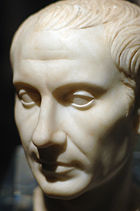
Initially, Rome was ruled by kings, who were elected from each of Rome's major tribes in turn. The exact nature of the king's power is uncertain. He may have held near-absolute power, or may also have merely been the chief executive of the Senate and the people. At least in military matters, the king's authority ( Imperium) was likely absolute. He was also the head of the state religion. In addition to the authority of the King, there were three administrative assemblies: the Senate, which acted as an advisory body for the King; the Comitia Curiata, which could endorse and ratify laws suggested by the King; and the Comitia Calata, which was an assembly of the priestly college which could assemble the people in order to bear witness to certain acts, hear proclamations, and declare the feast and holiday schedule for the next month.
The class struggles of the Roman Republic resulted in an unusual mixture of democracy and oligarchy. The word republic comes from the Latin res publica which literally translates to public business. Roman laws traditionally could only be passed by a vote of the Popular assembly ( Comitia Tributa). Likewise, candidates for public positions had to run for election by the people. However, the Roman Senate represented an oligarchic institution, which acted as an advisory body. In the Republic, the Senate held great authority (auctoritas), but no actual legislative power; it was technically only an advisory council. However, as the Senators were individually very influential, it was difficult to accomplish anything against the collective will of the Senate. New Senators were chosen from among the most accomplished patricians by Censors (Censura), who could also remove a Senator from his office if he was found "morally corrupt"; a charge that could include bribery or, as under Cato the Elder, embracing one's wife in public. Later, under the reforms of the dictator Sulla, Quaestors were made automatic members of the Senate, though most of his reforms did not survive.
The Republic had no fixed bureaucracy, and collected taxes through the practice of tax farming. Government positions such as quaestor, aedile, or praefect were funded from the office-holder's private finances. In order to prevent any citizen from gaining too much power, new magistrates were elected annually and had to share power with a colleague. For example, under normal conditions, the highest authority was held by two consuls. In an emergency, a temporary dictator could be appointed. Throughout the Republic, the administrative system was revised several times to comply with new demands. In the end, it proved inefficient for controlling the ever-expanding dominion of Rome, contributing to the establishment of the Roman Empire.
In the early Empire, the pretense of a republican form of government was maintained. The Roman Emperor was portrayed as only a princeps, or "first citizen", and the Senate gained legislative power and all legal authority previously held by the popular assemblies. However, the rule of the emperors became increasingly autocratic over time, and the Senate was reduced to an advisory body appointed by the emperor. The Empire did not inherit a set bureaucracy from the Republic, since the Republic did not have any permanent governmental structures apart from the Senate. The Emperor appointed assistants and advisers, but the state lacked many institutions, such as a centrally planned budget. Some historians have cited this as a significant reason for the decline of the Roman Empire.
The territory of the Empire was divided into provinces. The number of provinces increased with time, both as new territories were conquered and as provinces were divided into smaller units to discourage rebellions by powerful local rulers. Upon the rise of Augustus and the Principate, the provinces were divided into imperial and senatorial provinces, depending on which institution had the right to select the governor. During the Tetrarchy, the provinces of the empire were divided into 12 dioceses, each headed by a praetor vicarius. The civilian and military authority were separated, with civilian matters still administered by the governor, but with military command transferred to a dux.
On a local level, towns were divided into colonia, colonies composed of former soldiers or members of the Roman underclass, and municipia, towns composed of enfranchised provincials. These cities were given constitutions based on the Roman model, with the elected duovirs and aediles serving as magistrates, and with the local curia, appointed from men of property for life, serving in an advisory capability, similar to the Senate.
Law
The roots of the legal principles and practices of the ancient Romans may be traced to the law of the twelve tables (from 449 BC) to the codification of Emperor Justinian I (around 530 AD). Roman law as preserved in Justinian's codes continued into the Byzantine Empire, and formed the basis of similar codifications in continental Western Europe. Roman law continued, in a broader sense, to be applied throughout most of Europe until the end of the 17th century.
The major divisions of the law of ancient Rome, as contained within the Justinian and Theodosian law codes, consisted of Ius Civile, Ius Gentium, and Ius Naturale. The Ius Civile ("Citizen law") was the body of common laws that applied to Roman citizens. The Praetores Urbani (sg. Praetor Urbanus) were the individuals who had jurisdiction over cases involving citizens. The Ius Gentium ("Law of nations") was the body of common laws that applied to foreigners, and their dealings with Roman citizens. The Praetores Peregrini (sg. Praetor Peregrinus) were the individuals who had jurisdiction over cases involving citizens and foreigners. Ius Naturale encompassed natural law, the body of laws that were considered common to all being.
Economy
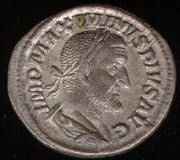
Ancient Rome commanded a vast area of land, with tremendous natural and human resources. As such, Rome's economy remained focused on agriculture and trade. Agricultural free trade changed the Italian landscape, and by the 1st century BC, vast grape and olive estates had supplanted the yeoman farmers, who were unable to match the imported grain price. The annexation of Egypt, Sicily and Tunisia in North Africa provided a continuous supply of grains. In turn, olive oil and wine were Italy's main exports. Two-tier crop rotation was practiced, but farm productivity was overall low, around 1 ton per hectare.
Industrial and manufacturing activities were smaller. The largest such activity were the mining and quarrying of stones, which provided basic construction materials for the buildings of that period. In manufacturing, production was on a relatively small scale, and generally consisted of workshops and small factories that employed at most dozens of workers. However, some brick factories employed hundreds of workers.
Some economic historians (like Peter Temin) argue that the economy of the Early Roman Empire was a market economy and one of the most advanced agricultural economies to have existed (in terms of productivity, urbanization and development of capital markets), comparable to the most advanced economies of the world before the Industrial Revolution, namely the economies of 18th century England and 17th century Netherlands. There were markets for every type of good, for land, for cargo ships; there was even an insurance market.
The economy of the early Republic was largely based on smallholding and paid labor. However, foreign wars and conquests made slaves increasingly cheap and plentiful, and by the late Republic, the economy was largely dependent on slave labor for both skilled and unskilled work. Slaves are estimated to have constituted around 20% of the Roman Empire's population at this time and 40% in the city of Rome. Only in the Roman Empire, when the conquests stopped and the prices of slaves increased, did hired labor become more economical than slave ownership.
Although barter was used in ancient Rome, and often used in tax collection, Rome had a very developed coinage system, with brass, bronze, and precious metal coins in circulation throughout the Empire and beyond—some have even been discovered in India. Before the 3rd century BC, copper was traded by weight, measured in unmarked lumps, across central Italy. The original copper coins ( as) had a face value of one Roman pound of copper, but weighed less. Thus, Roman money's utility as a unit of exchange consistently exceeded its intrinsic value as metal. After Nero began debasing the silver denarius, its legal value was an estimated one-third greater than its intrinsic.
Horses were too expensive, and other pack animals too slow, for mass trade on the Roman roads, which connected military posts rather than markets, and were rarely designed for wheels. As a result, there was little transport of commodities between Roman regions until the rise of Roman maritime trade in the 2nd century BC. During that period, a trading vessel took less than a month to complete a trip from Gades to Alexandria via Ostia, spanning the entire length of the Mediterranean. Transport by sea was around 60 times cheaper than by land, so the volume for such trips was much larger.
Class structure
Roman society is largely viewed as hierarchical, with slaves (servi) at the bottom, freedmen (liberti) above them, and free-born citizens (cives) at the top. Free citizens were themselves also divided by class. The broadest, and earliest, division was between the patricians, who could trace their ancestry to one of the 100 Patriarchs at the founding of the city, and the plebeians, who could not. This became less important in the later Republic, as some plebeian families became wealthy and entered politics, and some patrician families fell on hard times. Anyone, patrician or plebeian, who could count a consul as his ancestor was a noble (nobilis); a man who was the first of his family to hold the consulship, such as Marius or Cicero, was known as a novus homo ("new man") and ennobled his descendants. Patrician ancestry, however, still conferred considerable prestige, and many religious offices remained restricted to patricians.
A class division originally based on military service became more important. Membership of these classes was determined periodically by the Censors, according to property. The wealthiest were the Senatorial class, who dominated politics and command of the army. Next came the equestrians (equites, sometimes translated "knights"), originally those who could afford a warhorse, who formed a powerful mercantile class. Several further classes, originally based on what military equipment their members could afford, followed, with the proletarii, citizens who had no property at all, at the bottom. Before the reforms of Marius they were ineligible for military service and are often described as being just barely above freed slaves in terms of wealth and prestige.
Voting power in the Republic was dependent on class. Citizens were enrolled in voting "tribes", but the tribes of the richer classes had fewer members than the poorer ones, all the proletarii being enrolled in a single tribe. Voting was done in class order and stopped as soon as a majority of the tribes had been reached, so the poorer classes were often unable even to cast their votes.
Allied foreign cities were often given the Latin Right, an intermediary level between full citizens and foreigners (peregrini), which gave their citizens rights under Roman law and allowed their leading magistrates to become full Roman citizens. While there were varying degrees of Latin rights, the main division was between those con suffrage ("with vote"; enrolled in a Roman tribe and able to take part in the comitia tributa) and sans suffrage ("without vote"; unable to take part in Roman politics). Some of Rome's Italian allies were given full citizenship after the Social War of 91–88 BC, and full Roman citizenship was extended to all free-born men in the Empire by Caracalla in 212. Women shared some basic rights with their male counterparts, but were not fully regarded as citizens and were thus not allowed to vote or participate in politics.
Family
The basic units of Roman society were households and families. Households included the head (usually the father) of the household, pater familias (father of the family), his wife, children, and other relatives. In the upper classes, slaves and servants were also part of the household. The head of the household had great power (patria potestas, "father's power") over those living with him: He could force marriage (usually for money) and divorce, sell his children into slavery, claim his dependents' property as his own, and even had the right to punish or kill family members (though this last right apparently ceased to be exercised after the 1st century BC).
Patria potestas even extended over adult sons with their own households: A man was not considered a paterfamilias, nor could he truly hold property, while his own father lived. During the early period of Rome's history, a daughter, when she married, fell under the control (manus) of the paterfamilias of her husband's household, although by the late Republic this fell out of fashion, as a woman could choose to continue recognizing her father's family as her true family. However, as Romans reckoned descent through the male line, any children she had would belong to her husband's family.
Groups of related households formed a family ( gens). Families were based on blood ties or adoption, but were also political and economic alliances. Especially during the Roman Republic, some powerful families, or Gentes Maiores, came to dominate political life.
Ancient Roman marriage was often regarded more as a financial and political alliance than as a romantic association, especially in the upper classes. Fathers usually began seeking husbands for their daughters when they reached an age between twelve and fourteen. The husband was almost always older than the bride. While upper class girls married very young, there is evidence that lower class women often married in their late teens or early twenties.
Education
In the early Republic, there were no public schools, so boys were taught to read and write by their parents, or by educated slaves, called paedagogi, usually of Greek origin. The primary aim of education during this period was to train young men in agriculture, warfare, Roman traditions, and public affairs. Young boys learnt much about civic life by accompanying their fathers to religious and political functions, including the Senate for the sons of nobles. The sons of nobles were apprenticed to a prominent political figure at the age of 16, and campaigned with the army from the age of 17 (this system would still be in use among some noble families well into the imperial era). Educational practices were modified following the conquest of the Hellenistic kingdoms in the 3rd century BC and the resulting Greek influence, although it should be noted that Roman educational practices were still significantly different from Greek ones. If their parents could afford it, boys and some girls at the age of 7 were sent to a private school outside the home called a ludus, where a teacher (called a litterator or a magister ludi, and often of Greek origin) taught them basic reading, writing, arithmetic, and sometimes Greek, until the age of 11. Beginning at age 12, students went to secondary schools, where the teacher (now called a grammaticus) taught them about Greek and Roman literature. At the age of 16, some students went on to rhetoric school (where the teacher, almost always Greek, was called a rhetor). Education at this level prepared students for legal careers, and required that the students memorize the laws of Rome. Pupils went to school every day, except religious festivals and market days. There were also summer holidays.
Culture
Language

The native language of the Romans was Latin, an Italic language the grammar of which relies little on word order, conveying meaning through a system of affixes attached to word stems. Its alphabet was based on the Etruscan alphabet, which was in turn based on the Greek alphabet. Although surviving Latin literature consists almost entirely of Classical Latin, an artificial and highly stylized and polished literary language from the 1st century BC, the actual spoken language of the Roman Empire was Vulgar Latin, which significantly differed from Classical Latin in grammar and vocabulary, and eventually in pronunciation.
While Latin remained the main written language of the Roman Empire, Greek came to be the language spoken by the well-educated elite, as most of the literature studied by Romans was written in Greek. In the eastern half of the Roman Empire, which later became the Byzantine Empire, Latin was never able to replace Greek, and after the death of Justinian Greek became the official language of the Byzantine government. The expansion of the Roman Empire spread Latin throughout Europe, and over time Vulgar Latin evolved and dialectized in different locations, gradually shifting into a number of distinct Romance languages.
Although Latin is an extinct language with very few remaining fluent speakers, it remains in use in many ways, such as through Ecclesiastical Latin, the traditional language of the Roman Catholic Church and the official language of the Vatican City. Additionally, even after fading from common usage Latin maintained a role as western Europe's lingua franca, an international language of academia and diplomacy. Although eventually supplanted in this respect by French in the 19th century and English in the 20th, Latin continues to see heavy use in religious, legal, and scientific terminology—it has been estimated that 80% of all scholarly English words derive directly or indirectly from Latin.
Religion
Archaic Roman religion, at least concerning the gods, was made up not of written narratives, but rather of complex interrelations between gods and humans. Unlike in Greek mythology, the gods were not personified, but were vaguely-defined sacred spirits called numina. Romans also believed that every person, place or thing had its own genius, or divine soul. During the Roman Republic, Roman religion was organized under a strict system of priestly offices, which were held by men of senatorial rank. The College of Pontifices was uppermost body in this hierarchy, and its chief priest, the Pontifex Maximus, was the head of the state religion. Flamens took care of the cults of various gods, while augurs were trusted with taking the auspices. The sacred king took on the religious responsibilities of the deposed kings. In the Roman empire, emperors were held to be gods, and the formalized imperial cult became increasingly prominent.
As contact with the Greeks increased, the old Roman gods became increasingly associated with Greek gods. Thus, Jupiter was perceived to be the same deity as Zeus, Mars became associated with Ares, and Neptune with Poseidon. The Roman gods also assumed the attributes and mythologies of these Greek gods. The transferral of anthropomorphic qualities to Roman Gods, and the prevalence of Greek philosophy among well-educated Romans, brought about an increasing neglect of the old rites, and in the 1st century BC, the religious importance of the old priestly offices declined rapidly, though their civic importance and political influence remained. Roman religion in the empire tended more and more to centre on the imperial house, and several emperors were deified after their deaths.
Under the empire, the Romans absorbed the mythologies of their conquered subjects, often leading to situations in which the temples and priests of traditional Italian deities existed side by side with those of foreign gods. Numerous foreign cults grew popular, such as the worship of the Egyptian Isis and the Persian Mithras. Beginning in the 2nd century, Christianity began to spread in the Empire, despite initial persecution. Beginning with Emperor Nero, Roman official policy towards Christianity was negative, and at some points, simply being a Christian could be punishable by death. Under Emperor Diocletian, the persecution of Christians reached its peak. However, it became an officially supported religion in the Roman state under Constantine I and became exponentially popular. After a brief and unsuccessful pagan revival by the emperor Julian the Apostate Christianity became the permanent religion of the empire. All religions except Christianity were prohibited in 391 by an edict of Emperor Theodosius I.
Art, music and literature
Roman painting styles show Greek influences, and surviving examples are primarily frescoes used to adorn the walls and ceilings of country villas, though Roman literature includes mentions of paintings on wood, ivory, and other materials. Several examples of Roman painting have been found at Pompeii, and from these art historians divide the history of Roman painting into four periods. The first style of Roman painting was practiced from the early 2nd century BC to the early- or mid-1st century BC. It was mainly composed of imitations of marble and masonry, though sometimes including depictions of mythological characters. The second style of Roman painting began during the early 1st century BC, and attempted to realistically depict three-dimensional architectural features and landscapes. The third style occurred during the reign of Augustus (27 BC – 14 AD), and rejected the realism of the second style in favor of simple ornamentation. A small architectural scene, landscape, or abstract design was placed in the centre with a monochrome background. The fourth style, which began in the 1st century AD, depicted scenes from mythology, while retaining architectural details and abstract patterns.
Portrait sculpture during the period utilized youthful and classical proportions, evolving later into a mixture of realism and idealism. During the Antonine and Severan periods, more ornate hair and bearding became prevalent, created with deeper cutting and drilling. Advancements were also made in relief sculptures, usually depicting Roman victories.
Latin literature was from its very inception influenced heavily by Greek authors. Some of the earliest extant works are of historical epics telling the early military history of Rome. As the Republic expanded, authors began to produce poetry, comedy, history, and tragedy.
Roman music was largely based on Greek music, and played an important part in many aspects of Roman life. In the Roman military, musical instruments such as the tuba (a long trumpet) or the cornu (similar to a French horn) were used to give various commands, while the bucina (possibly a trumpet or horn) and the lituus (probably an elongated J-shaped instrument), were used in ceremonial capacities. Music was used in the amphitheaters between fights and in the odea, and in these settings is known to have featured the cornu and the hydraulis (a type of water organ). The majority of religious rituals featured musical performances, with tibiae (double pipes) at sacrifices, cymbals and tambourines at orgiastic cults, and rattles and hymns across the spectrum. Some music historians believe that music was used at almost all public ceremonies. Music historians are not certain as to whether or not Roman musicians made a significant contribution to the theory or practice of music.
The graffiti, brothels, paintings, and sculptures found in Pompeii and Herculaneum suggest that the Romans had a very sex-saturated culture.
Games and activities
The youth of Rome had several forms of play and exercise, such as jumping, wrestling, boxing, and racing. In the countryside, pastimes for the wealthy also included fishing and hunting. The Romans also had several forms of ball playing, including one resembling handball. Dice games, board games, and gamble games were extremely popular pastimes. Women did not participate in these activities. For the wealthy, dinner parties presented an opportunity for entertainment, sometimes featuring music, dancing, and poetry readings. Plebeians sometimes enjoyed such parties through clubs or associations, although recreational dining usually meant patronizing taverns. Children entertained themselves with toys and such games as leapfrog.
A popular form of entertainment were gladiatorial combats. Gladiators fought either to the death, or to "first blood" with a variety of weapons and in a variety of different scenarios. These fights achieved their height of popularity under the emperor Claudius, who placed the final outcome of the combat firmly in the hands of the emperor with a hand gesture. Contrary to popular representations in film, several experts believe the gesture for death was not "thumbs down". Although no one is certain as to what the gestures were, some experts conclude that the emperor would signify "death" by holding a raised fist to the winning combatant and then extending his thumb upwards, while "mercy" was indicated by a raised fist with no extended thumb. Animal shows were also popular with the Romans, where foreign animals were either displayed for the public or combined with gladiatorial combat. A prisoner or gladiator, armed or unarmed, was thrown into the arena and an animal was released.
The Circus Maximus, another popular site in Rome, was primarily used for horse and chariot racing, and when the circus was flooded, there were even sea battles. It was also used in many other events. It could hold up to 385,000 people; people all over Rome would visit it. Two temples, one with seven large eggs and one with seven dolphins, lay in the middle of the track of Circus Maximus, and whenever the racers made a lap, one of each would be removed. This was done to keep the spectators and the racers informed on the race statistics. Other than sports, the Circus Maximus was also an area of marketing and gambling. Higher authorities, like the emperor, also attended games in the Circus Maximus, as it was rude not to. They, knights, and many other people who were involved with the race sat in reserved seats located above everyone else. It was also found rude for emperors to root for a team. The Circus Maximus was created in 600 BC and hosted the last horse-racing game in 549 AD, lasting for over a millennium.
Technology
Ancient Rome boasted the most impressive technological feats of its day, using many advancements that would be lost in the Middle Ages and not be rivaled again until the 19th and 20th centuries. But though adept at adopting and synthesizing other cultures' technologies, the Roman civilization was not especially innovative or progressive. Many practical Roman innovations were adopted from earlier Greek designs. New ideas were rarely developed. Roman society considered the articulate soldier who could wisely govern a large household the ideal, and Roman law made no provisions for intellectual property or the promotion of invention. The concept of "scientists" and "engineers" did not yet exist, and advancements were often divided based on craft, as groups of artisans jealously guarded new technologies as trade secrets. Nevertheless, a number of vital technological breakthroughs were spread and thoroughly used by Rome, contributing to an enormous degree to Rome's dominance and lasting influence in Europe.
Engineering
Roman engineering constituted a large portion of Rome's technological superiority and legacy, and contributed to the construction of hundreds of roads, bridges, aqueducts, baths, theaters and arenas. Many monuments, such as the Colosseum, Pont du Gard, and Pantheon, still remain as testaments to Roman engineering and culture.
Architecture
The Romans were particularly renowned for their architecture, which is grouped with Greek traditions into " Classical architecture". During the Roman Republic, it remained stylistically almost identical to Greek architecture. Although there were many differences from Greek architecture, Rome borrowed heavily from Greece in adhering to strict, formulaic building designs and proportions. Aside from two new orders of columns, composite and Tuscan, and from the dome, which was derived from the Etruscan arch, Rome had relatively few architectural innovations until the end of the Republic.
Then, in the 1st century BC, Romans started to widely use concrete, invented in the late 3rd century BC. It was a powerful cement derived from pozzolana, and soon supplanted marble as the chief Roman building material and allowed many daring architectural schemata. Also in the 1st century BC, Vitruvius wrote De architectura, possibly the first complete treatise on architecture in history. In late 1st century BC, Rome also began to use glassblowing soon after its invention in Syria about 50 BC. Mosaics took the Empire by storm after samples were retrieved during Lucius Cornelius Sulla's campaigns in Greece. Article on history of Roman concrete
Roads
Concrete made possible the paved, durable Roman roads, many of which were still in use a thousand years after the fall of Rome. The construction of a vast and efficient travel network throughout the Empire dramatically increased Rome's power and influence. It was originally constructed to allow Roman legions to be rapidly deployed. But these highways also had enormous economic significance, solidifying Rome's role as a trading crossroads—the origin of the saying "all roads lead to Rome". The Roman government maintained way stations which provided refreshments to travelers at regular intervals along the roads, constructed bridges where necessary, and established a system of horse relays for couriers that allowed a dispatch to travel up to 800 kilometers (500 mi) in 24 hours.
Aqueducts
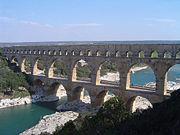
The Romans constructed numerous aqueducts to supply water to cities and industrial sites and to assist in their agriculture. The city of Rome was supplied by 11 aqueducts with a combined length of 350 kilometres (220 mi). Most aqueducts were constructed below the surface, with only small portions above ground supported by arches. Sometimes, where depressions deeper than 50 metres (165 ft) had to be crossed, inverted siphons were used to force water uphill.
Sewers
The Romans also made major advancements in sanitation. Romans were particularly famous for their public baths, called thermae, which were used for both hygienic and social purposes. Many Roman houses came to have flush toilets and indoor plumbing, and a complex sewer system, the Cloaca Maxima, was used to drain the local marshes and carry waste into the Tiber river. Some historians have speculated that the use of lead pipes in the sewer and plumbing systems led to widespread lead poisoning which contributed to the decline in birth rate and general decay of Roman society leading up to the fall of Rome. However, lead content would have been minimized because the flow of water from aqueducts could not be shut off; it ran continuously through public and private outlets into the drains, and only a small number of taps were in use.
Military
The early Roman army (c. 500 BC) was, like those of other contemporary city-states influenced by Greek civilization, a citizen militia which practiced hoplite tactics. It was small (the population of free males of military age was then about 9,000) and organized in five classes (in parallel to the comitia centuriata, the body of citizens organized politically), with three providing hoplites and two providing light infantry. The early Roman army was tactically limited and its stance during this period was essentially defensive. By the 3rd century BC, the Romans abandoned the hoplite formation in favour of a more flexible system in which smaller groups of 120 (or in some cases 60) men called maniples could maneuver more independently on the battlefield. Thirty maniples arranged in three lines with supporting troops constituted a legion, totaling between 4,000 and 5,000 men. The early Republican legion consisted of five sections, each of which was equipped differently and had different places in formation: the three lines of manipular heavy infantry ( hastati, principes and triarii), a force of light infantry ( velites), and the cavalry ( equites). With the new organization came a new orientation toward the offensive and a much more aggressive posture toward adjoining city-states.
At nominal full strength, an early Republican legion would have included 3,600 to 4,800 heavy infantry, several hundred light infantry and several hundred cavalrymen, for a total of 4,000 to 5,000 men. Legions were often significantly understrength from recruitment failures or following periods of active service due to accidents, battle casualties, disease and desertion. During the Civil War, Pompey's legions in the east were at full strength because recently recruited, while Caesar's legions were in many cases well below nominal strength after long active service in Gaul. This pattern also held true for auxiliary forces.
As described by Goldsworthy, both the Greek and Roman phalanx and the early Republican legions were intended to fight large scale battles involving a single quick, decisive clash with the enemy. At this they were generally very successful. At the time of the Marian reforms in the late Republic (c. 100 BC), further organizational change created a more flexible, resilient and versatile force. The legion was now divided into ten cohorts of 480 men each, comprising three of the old maniples (now called centuriae or "centuries" commanded by a centurion). Moreover, the velites (light infantry) and (probably) the equites were eliminated and replaced by auxilia (auxiliary units of cavalry, archers and slingers, and light infantry, usually recruited from non-citizens). There were no other subdivisions within a legion, but many men with specialized skills—medics, engineers, technicians, artillerymen—were included among the legionaries. The centuries in a cohort had a unified command structure and were experienced at working with the other centuries in the cohort as a unit. A legion organized in cohorts was easier to control, and cohorts could easily be detached and act independently where that was useful on the battlefield or a separate smaller force was needed. Accordingly, legions organized in cohorts could conduct operations of almost any scale.
Three long-term trends characterized the development of the Roman army over its history: increasing professionalization, a widening of the base for recruitment, and an increase in the variety and flexibility of military units. Until the late Republican period, the typical legionary was a property-owning citizen farmer from a rural area (an adsiduus) who served for particular (often annual) campaigns, and who supplied his own equipment and, in the case of equites, his own mount. Harris suggests that down to 200 BC, the average rural farmer (who survived) might participate in six or seven campaigns. Freedmen and slaves (wherever resident) and urban citizens did not serve except in rare emergencies. After 200 BC, economic conditions in rural areas deteriorated as manpower needs increased, so that the property qualifications for service were gradually reduced. Beginning with Gaius Marius in 107 BC, citizens without property and some urban-dwelling citizens (proletarii) were enlisted and provided with equipment, although most legionaries continued to come from rural areas. Terms of service became continuous and long—up to twenty years if emergencies required it although Brunt argues that six or seven years was more typical. Beginning in the 3rd century BC, legionaries were paid stipendium (amounts are disputed but Caesar famously "doubled" payments to his troops to 225 denarii a year), could anticipate booty and donatives (distributions of plunder by commanders) from successful campaigns and, beginning at the time of Marius, often were granted allotments of land upon retirement. Cavalry and light infantry attached to a legion (the auxilia) were often recruited in the areas where the legion served. These troops were familiar with local conditions and fought in a style adapted to the local terrain. Caesar formed a legion, the Fifth Alaudae, from non-citizens in Transalpine Gaul to serve in his campaigns in Gaul. During the Civil War when large armies were required, both sides raised legions from non-citizens, as Goldsworthy notes, "without bothering with the formality of granting citizenship to the men on enlistment." By the time of Caesar Augustus, the ideal of the citizen-soldier had been abandoned and the legions had become fully professional. Legionaries were paid 900 sesterces a year and could expect a payment of 12,000 sesterces on retirement.
At the end of the Civil War, Augustus reorganized Roman military forces, discharging soldiers and disbanding legions. He retained 28 legions, which were now based in permanent camps on the frontier along the Rhine and Danube Rivers and in Syria. Composed of about 150,000 citizen legionaries, an approximately equal number of auxilia and a navy of unknown size, this establishment remained the standard until late in the history of the Empire. During the Principate, with a few exceptions, warfare was conducted on a smaller scale. The auxilia were not organized into larger units but remained independent cohorts, and legionary troops themselves often operated as groups of cohorts rather than as full legions. A new versatile type of unit, the cohortes equitatae, combining cavalry and legionaries in a single formation could be stationed at garrisons or outposts, could fight on their own as balanced small forces or could combine with other similar units as a larger legion-sized force. This increase in organizational flexibility over time helped ensure the long-term success of Roman military forces.
The Emperor Gallienus (253–268 AD) began yet another reorganization that created the final military structure of the late Empire. Withdrawing some legionaries from the fixed bases on the border, Gallienus created mobile forces (the Comitatenses or field armies) and stationed them behind and at some distance from the borders as a strategic reserve. This reduced the need to move troops from one province to another to reinforce the border in case of attacks. The border troops (limitanei) stationed at fixed bases continued to be the first line of defense. The Emperor Diocletian (284–305 AD) reversed this reorganization but it became the norm by the middle of the 4th century AD. Diocletian also introduced the so-called Tetrarchy under which the Eastern and Western halves of the Empire were each governed by an "Augustus" (Emperor) and a "Caesar" (junior Emperor), who resided at different locations near the borders and commanded troops within their respective regions. The basic unit of the field army was the "regiment", legiones or auxilia for infantry and vexellationes for cavalry. Evidence suggests that nominal strengths may have been 1,200 men for infantry regiments and 600 for cavalry, although many records show lower actual troop levels (800 and 400). Many infantry and cavalry regiments operated in pairs under the command of a comes. In addition to Roman troops, the field armies included regiments of "barbarians" recruited from allied tribes and known as foederati. By 400 AD, foederati regiments had become permanently established units of the Roman army, paid and equipped by the Empire, led by a Roman tribune and used just as Roman units were used. In addition to the foederati, the Empire also used groups of barbarians to fight along with the legions as "allies" without integration into the field armies. Under the command of the senior Roman general present, they were led at lower levels by their own officers.
The nature of military leadership evolved greatly over the course of the history of Rome. Under the monarchy, the hoplite armies would have been led by the kings of Rome. During the early and middle Roman Republic, military forces were under the command of one of the two elected consuls for the year. During the later Republic, members of the Roman Senatorial elite, as part of the normal sequence of elected public offices known as the cursus honorum, would have served first as quaestor (often posted as deputies to field commanders), then as praetor (sometimes posted as provincial governors in charge of military forces in the relevant province), then as consul (supreme command of all military forces). Following the end of a term as praetor or consul, a Senator might be appointed by the Senate as a propraetor or proconsul (depending on the highest office previously held) to govern a foreign province. More junior officers (down to but not including the level of centurion) were selected by their commanders from their own clientelae or those recommended by political allies among the Senatorial elite. Under Augustus, whose most important political priority was to place the military under a permanent and unitary command, the Emperor was the legal commander of each legion but exercised that command through a legatus (legate) he appointed from the Senatorial elite. In a province with a single legion, the legate would command the legion (legatus legionis) and also serve as provincial governor, while in a province with more than one legion, each legion would be commanded by a legate and the legates would be commanded by the provincial governor (also a legate but of higher rank). During the later stages of the Imperial period (beginning perhaps with Diocletian), the Augustan model was abandoned. Provincial governors were stripped of military authority, and command of the armies in a group of provinces was given to generals ( duces) appointed by the Emperor. These were no longer members of the Roman elite but men who came up through the ranks and had seen much practical soldiering. With increasing frequency, these men attempted (sometimes successfully) to usurp the positions of the Emperors who had appointed them. Decreased resources, increasing political chaos and civil war eventually left the Western Empire vulnerable to attack and takeover by neighboring barbarian peoples.
Comparatively less is known about the Roman navy than the Roman army. Prior to the middle of the 3rd century BC, officials known as duumviri navales commanded a fleet of twenty ships used mainly to control piracy. This fleet was given up in 278 AD and replaced by allied forces. The First Punic War required that Rome build large fleets, and it did so largely with the assistance of and financing from allies. This reliance on allies continued to the end of the Roman Republic. The quinquireme was the main warship on both sides of the Punic Wars and remained the mainstay of Roman naval forces until replaced by the time of Caesar Augustus by lighter and more maneuverable vessels. As compared with a trireme, the quinquireme permitted the use of a mix of experienced and inexperienced crewmen (an advantage for a primarily land-based power), and its lesser maneuverability permitted the Romans to adopt and perfect boarding tactics using a troop of approximately 40 marines in lieu of the ram. Ships were commanded by a navarch, a rank equivalent to a centurion, who were usually not citizens. Potter suggests that because the fleet was dominated by non-Romans, the navy was considered non-Roman and allowed to atrophy in times of peace.
Available information suggests that by the time of the late Empire (350 AD), the Roman navy comprised a number of fleets including both warships and merchant vessels for transportation and supply. Warships were oared sailing galleys with three to five banks of oarsmen. Fleet bases included such ports as Ravenna, Arles, Aquilea, Misenum and the mouth of the Somme River in the West and Alexandria and Rhodes in the East. Flotillas of small river craft (classes) were part of the limitanei (border troops) during this period, based at fortified river harbors along the Rhine and the Danube. The fact that prominent generals commanded both armies and fleets suggests that naval forces were treated as auxiliaries to the army and not as an independent service. The details of command structure and fleet strengths during this period are not well known although it is known that fleets were commanded by prefects.
Scholarly studies
The interest in studying ancient Rome arose presumably during the Age of Enlightenment in France. Charles Montesquieu wrote a work Reflections on the Causes of the Grandeur and Declension of the Romans. The first major work was The History of the Decline and Fall of the Roman Empire by Edward Gibbon, which encompassed the period from the end of 2nd century to the fall of the Byzantine Empire in 1453. Like Montesquieu Gibbon paid high tribute to the virtue of Roman citizens. Barthold Georg Niebuhr was a founder of the criticism and wrote The Roman History, carried until the First Punic war. Niebuhr has made an attempt to determine the way the Roman tradition appeared. According to him, Romans, like other people, had a historical ethos which was preserved mainly in the noble families. During the Napoleonic period the work titled The History of Romans by Victor Duruy appeared. It highlighted the Caesarean period popular at the time. History of Rome, Roman constitutional law and Corpus Inscriptionum Latinarum, all by Theodor Mommsen, became very important milestones. Later the work Greatness and Decline of Rome by Guglielmo Ferrero was published. The Russian work Очерки по истории римского землевладения, преимущественно в эпоху Империи (The Outlines on Roman Landownership History, Mainly During the Empire) by Ivan Grevs contained information on the economy of Pomponius Atticus, one of the greatest landowners during the end of the Republic.
